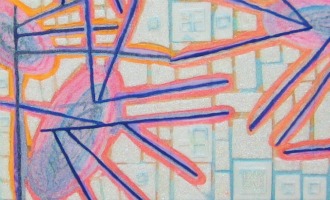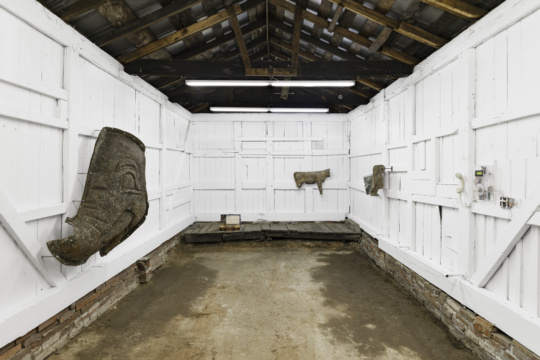
For your summer reading pleasure, BURNAWAY brings you Just Like Suicide, a novel by artist Mery Lynn McCorkle, set in the Los Angeles art world. She writes from experience, having lived for years in Williamsburg, Brooklyn, when it still was the art frontier, and then LA; she now resides in Rome, Georgia. She describes the book as “a compendium of interlocking tales cataloguing self demolition and success in the Los Angeles art scene, from the point of view of artists, dealers and family members.”
We’ll post sequential chapters from McCorkle’s book every Wednesday and Friday over the summer. Or click here to buy the book now.
Seventeen
He was fortunate, Tommy reminded himself the way everyone else did incessantly, to have experienced any success at all. His canvases had left the studio wet. He had a waiting list of buyers before he even got his masters degree. Before he left school, he was showing in major galleries. Immediately after graduating, he had solo shows internationally. Galleries had even paid for his airfare.
And for his twenty eighth birthday, it all stopped. The economy crashed. The reviewers who had extolled his virtuosity decried his lack of growth.
It had always felt like a trick. He would drink and snort a little coke or take X or meth, anything available which didn’t need a needle, and then lock himself in the studio and paint. It just flowed out of him, not really even his work. It was the drugs talking. He was just the tool. He and Hondo agreed on this – they were simply vehicles for Art, a transport system. Drugs are the highway to heaven, Hondo told him, nicknaming him “Tank.” A tank in the china shop of Art. Oh, damn, he missed Hondo and that habit of flinging his hair like he was a wet dog. Every one of his paintings had some of Hondo’s long hair trapped in it. Having him in the studio was worse than having a cat around. A cat who spoke art and carried joints in his boots. Who would play the drums to his guitar now? And his truck: who was going to help him repair his truck? Oh, blast you, Hondo. Why did he refuse to take everyone’s advice to back off the drugs? They would have helped him through it. He wouldn’t have had to do it alone. But he could hear Hondo laughing and telling him that our mistakes, our weaknesses are our most unguarded self. Our mistakes are the most honest things about us. And wasn’t honesty the point of art? Stop it. He shouldn’t allow himself to think about Hondo and dive back into despair.
After Hondo died and Alex moved to New York, his mother tried every homeopathic remedy on him. When none of them worked, she broke down and checked him into a clinic. Surprise, surprise, he was diagnosed with depression and for the next year bounced between “cures.” What a joke. Six to eight weeks on this. Six to eight weeks waiting to see if the next one worked. None of them worked much better than the homeopathic stuff his mother had pushed him to take and some were worse. Most of the time he felt like he had a garbage bag over his head, slowly suffocating himself.
He couldn’t paint. He couldn’t feel. He couldn’t think. He couldn’t even sing.
At first, he and Lori had cried together. She had really listened to him and agreed that it was all so unfair. Then she started shrugging. Finally she told him to get over it, to readjust his medication, readjust his attitude, readjust his goals. Then she left to marry some dude from the Valley.
“Lord knows art is a fickle god, capricious and how limitless it can feel, like a pit oozing tar, an oasis of stinking dark matter in the desolation of day. Watch me, lord art, sink onto bruised knees and crawl for those amber rays of light, the light at the end of the tunnel, the end of the endless war between moxidase and vampire gift. The dark dase and a gift-like Trojan horse come to carry me away. So sleepless now that Nardil ebbs along my shores, my shins, my chinny chin chins. Wasted, wasting even a feast of scraps of Camembert and Beaujolais past its prime, observing the fierce rituals of the long deprived. Smell the unmistakable aftertaste of young red wine. Red lips from licking. The forest of empty green bottles. Yes, our dreams and anguish bind us, barbed wire to silken thread. And even in the evenings when I lay me down to sleep, counting sheep, only to intone the genealogy of medications since Day One. A genesis of how fish are jumping and the cotton is high. You see, in the beginning was darkness. And the lords of Pfizer said let there be light and there was light. How blessed are the generations of the progeny of Iproniazid: Elavil begat Prozac begat Lexapro, Zoloft and Wellbutrin, Paxil and Tofranil, Celexa and Desyrel who was barren, then Pamelor and Remeron who begat Cymbalta and Effexor and the demon Luvox. And their stupefying daughter Nardil. Not the least of these, the Augmentors, those angels of mercy, Buspar, Ariza, the fair Xanax, Serzone, and Sediel. And standing before them all, the luminous Archangel Lithium, the gatekeeper to Heavenly Peace, found abundant in the hollows, the hide of Afghanistan.”
The next day when Tommy Malinowski stumbled into his studio, he found that scrawled in red paint and 4B pencil across the largest wall, the one he had spent the weekend carefully painting white, attempting to clear his mind by erasing the mess of the past silhouetted on the wall. He had no clear memory of writing it. “Too bad I didn’t do this on you,” he scolded the row of pristine canvases, the blank whiteness circling around the room. “Now that would have been a new direction, don’t you think? Well, probably not. Text on canvas is kind of trite these days.”
He sat on the dirty floor for an hour staring at the empty canvases surrounding him, drinking the wine still left in the bottle from last night, wishing he had another bottle hidden somewhere. Thinking how completely he embodied the line from Whitman, “sluggish existences grazing there suspended.”
Sluggish indeed. He couldn’t do the work anymore. After the last scathing review lambasting his work as static, criticizing him for not developing his ideas, stopping just short of calling him a one trick wonder, gallery after gallery had stopped returning his phone calls. Other artists looked upon him with pity at openings. Three painters he considered total losers came up to commiserate with him. He was officially a failure.
Darkness. Darkness everywhere. Even the harsh California light seemed subdued, bathed in polluted grey. “Boy, am I melodramatic,” he told the bottle as he took the final swig and threw it at the white wall. It fell short and didn’t even break. What a loser. Alex was right. Losers were losers because they wallowed in self pity. Picking himself up, he flicked his thinning hair the way Hondo had, grabbed a new can of black house paint. He shook it and shook it until he was covered in sweat. “Now that’s what I call getting exercise!” he wheezed at the canvases as he took the screwdriver from on top of the cabinet and hammered it into the top of the can in three places. Then, after emptying his overloaded pockets, he began to dance, swinging the can, twirling himself, a dervish spewing strings of blackness around the room, onto those pristine white canvases, dripping down in clots, killing the whiteness, filling the void.
When he finished, he felt like he was choking, like he couldn’t swallow, gagging on the wine so bad he threw up, adding a patch of red tinted bile on top of the sticky black paint on the floor. He put a wad of paper towels on top of it and left it to dry.
Couldn’t the critics see that the gusto they so adored in the earlier work, all those gestural marks and gashes of color, the “vivacity of his technique,” were his way of hiding the emptiness, wishing it away in a miasma of texture and sweat and semen? And change: hadn’t the critics ever read about primitive religious practices? Like any effective incantation, elements had to be repeated exactly the same to work. Any deviation and the demon gods would not be appeased and everything would collapse.
Nothing, though, nothing ever stayed the same.




